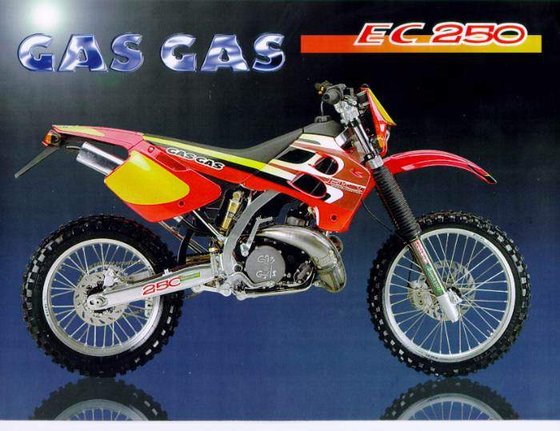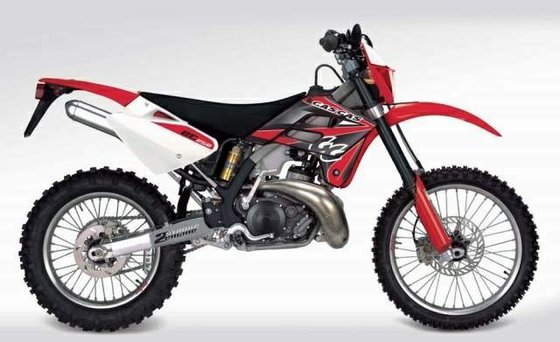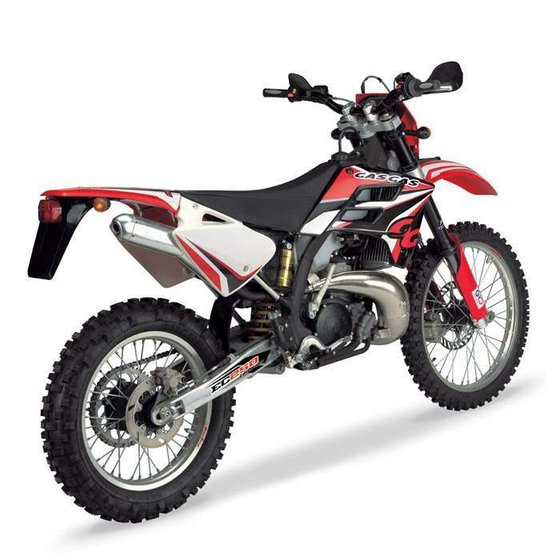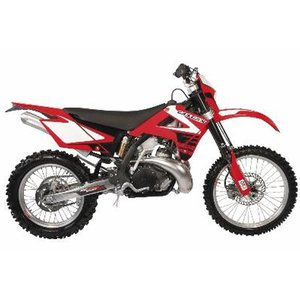Gas Gas EC 250 2T (2002-2005): A Time-Tested Enduro Warrior Revisited

Introduction
The Gas Gas EC 250 2T represents a golden era of European enduro motorcycles, built during a time when two-stroke dominance in off-road racing was still unchallenged. From 2002 to 2005, this Spanish machine carved its reputation as a lightweight, agile, and brutally effective off-road weapon. Designed for riders who demanded precision in technical terrain and reliability in grueling conditions, the EC 250 remains a compelling choice for vintage enduro enthusiasts and hardcore trail riders today. Let’s dissect why this bike still turns heads in the woods and how it holds up against modern expectations.
Key Features at a Glance
- Engine: 249.3 cc liquid-cooled two-stroke single-cylinder
- Power: 49.8 HP @ 8,600 RPM / 45.6 Nm torque @ 7,628 RPM
- Weight: 102 kg (225 lbs) dry
- Suspension Travel: 295 mm (11.6") front / 320 mm (12.6") rear
- Ground Clearance: 340 mm (13.4")
- Fuel Capacity: 9.5L (2.5 US gal)

On the Trail: Riding Impressions
The Heartbeat of a Two-Stroke
Swing a leg over the EC 250, and the first sensation is the raw immediacy of its two-stroke engine. The 38mm Keihin PWK carburetor delivers a crisp throttle response, with a powerband that explodes to life in the mid-range. Unlike modern fuel-injected bikes, there’s an art to tuning this carbureted beast – a slightly rich jetting keeps it from detonating in technical climbs, while leaning it out unlocks a frenetic top-end rush.
The hydraulic clutch (a rarity in its class at the time) offers buttery modulation, letting you feather the power through rocky sections without arm pump. On fast fire roads, the 6-speed gearbox encourages you to chase the 8,600 RPM redline, though the sweet spot lies between 5,500–7,500 RPM where torque and traction harmonize.

Handling: Precision Over Plushness
Gas Gas’s Deltabox chromoly frame strikes a balance between rigidity and flex. At 1,475 mm (58.1") wheelbase, the EC 250 feels compact – almost trials-bike nimble in tight singletrack. The Marzocchi 45mm USD forks and Öhlins rear shock prioritize progressive damping over plushness, making it exceptionally stable at speed through choppy terrain.
However, this setup demands active riding. The 21"/18" wheel combo (90/90-21 front, 120/80-18 rear) requires commitment when railing berms, but the 340 mm (13.4") ground clearance lets you straddle logs and boulders with impunity. At 102 kg (225 lbs) dry, it’s no featherweight by modern standards, but the mass centralization makes it feel lighter than the numbers suggest.
Ergonomics: Form Follows Function
The 945 mm (37.2") seat height is intimidating for shorter riders but perfect for stand-up attacking. The narrow chassis lets you grip the bike with your knees effortlessly, while the flat seat-to-peg relationship accommodates taller riders. The 9.5L tank is small by dual-sport standards but adequate for 2–3 hours of hard enduro. Pro tip: Install a grippy aftermarket seat cover – the stock vinyl gets slippery when muddy.
Competition: How It Stacks Up
vs. KTM 250 EXC (2002–2005)
KTM’s rival had a broader powerband and WP suspension tuned for versatility. However, the EC 250’s Öhlins shock outclassed the WP unit in high-speed damping, making it more stable in whoops. Gas Gas also boasted better standard handlebars and a stiffer frame for aggressive riders.
vs. Husqvarna WR250 (2-Stroke)
The Husky felt taller and more top-heavy, with a focus on high-speed stability. Gas Gas countered with quicker steering and superior low-RPM tractability, thanks to its exhaust porting and carburetion. Maintenance was a toss-up – both required frequent top-end rebuilds but offered easy access to engines.
vs. Yamaha WR250F (4-Stroke)
The Yamaha’s four-stroke torque was easier for beginners, but the EC 250’s power-to-weight ratio (0.49 HP/kg vs. 0.38 HP/kg) made it faster in expert hands. The Gas Gas also had simpler maintenance (no valve adjustments) but demanded premix diligence.
Maintenance: Keeping the Beast Alive
Critical Service Points
- Top-End Rebuilds: Every 50–80 hours, depending on riding style. Look for piston skirt wear and replace rings at 30-hour intervals.
- Carburetor Tuning: Clean the Keihin PWK every 20 hours. Upgrade to a JD Jet Kit for altitude versatility.
- Suspension Service: Rebuild Marzocchi forks annually; Öhlins shocks benefit from a nitrogen recharge every 2 years.
- Air Filter: Oil foam filters after every ride – the stock cage design allows debris ingress.
MOTOPARTS.store Upgrades
- High-Compression Pistons: Boost low-end grunt without sacrificing reliability.
- Skid Plates: Protect the fragile magnesium clutch cover.
- Brake Pads: Swap to sintered pads for improved bite on the 260mm front disc.
- Suspension Springs: Tailor rates for your weight – stock setup favors 70–80 kg riders.
Conclusion: A Legacy Worth Preserving
The Gas Gas EC 250 2T isn’t a retro novelty – it’s a legitimate contender for riders who value mechanical simplicity and tactile feedback. While modern enduro bikes have eclipsed it in weight savings and electronic aids, the 2002–2005 EC 250 remains a masterclass in analog off-road performance. With judicious upgrades (readily available through MOTOPARTS.store), this Spanish stallion can still humble newer machines in the right terrain. For the purist who enjoys the ritual of premixing fuel and the scream of a tuned two-stroke, few bikes deliver as much raw satisfaction per dollar.
Ready to revitalize your EC 250? Explore our curated selection of performance parts and heritage accessories designed to keep this legend alive.
Specifications sheet
| Engine | |
|---|---|
| Stroke: | Two-stroke |
| Ignition: | Kokusan digital CDI |
| Max power: | 36 kW | 48.0 hp |
| Max torque: | 46 Nm |
| Fuel system: | 38mm Keihin PWK Carburettor |
| Lubrication: | 2.5% fuel/oil mixture (40:1) |
| Max power @: | 8600 rpm |
| Displacement: | 249 ccm |
| Max torque @: | 7628 rpm |
| Bore x stroke: | 66.4 x 72.0 mm (2.6 x 2.8 in) |
| Configuration: | Single |
| Cooling system: | Liquid |
| Starting system: | Kick |
| Number of cylinders: | 1 |
| Dimensions | |
|---|---|
| Wheelbase: | 1475 mm (58.1 in) |
| Dry weight: | 102 |
| Seat height: | 940 mm (37.0 in) |
| Ground clearance: | 340 mm (13.4 in) |
| Fuel tank capacity: | 9.5 L (2.5 US gal) |
| Drivetrain | |
|---|---|
| Clutch: | Hydraulic multidisc |
| Final drive: | chain |
| Transmission: | 6-speed |
| Maintenance | |
|---|---|
| Coolant capacity: | 1.2 |
| Rear brake fluid: | DOT 4 |
| Fork oil capacity: | 1.1 |
| Front brake fluid: | DOT 4 |
| Fuel/oil mixture ratio: | 2.5% (40:1) |
| Transmission oil capacity: | 0.7 |
| Chassis and Suspension | |
|---|---|
| Frame: | Deltabox type, cromoly rectangular tube frame with aluminum swingarm |
| Rear brakes: | Single 220 mm disc, 1-piston caliper |
| Front brakes: | Single 260 mm disc, 1-piston caliper |
| Rear suspension: | Progressive system with Öhlins shock absorber |
| Front suspension: | 45mm Marzocchi upside-down telescopic fork |
| Rear wheel travel: | 320 mm (12.6 in) |
| Front wheel travel: | 295 mm (11.6 in) |



















